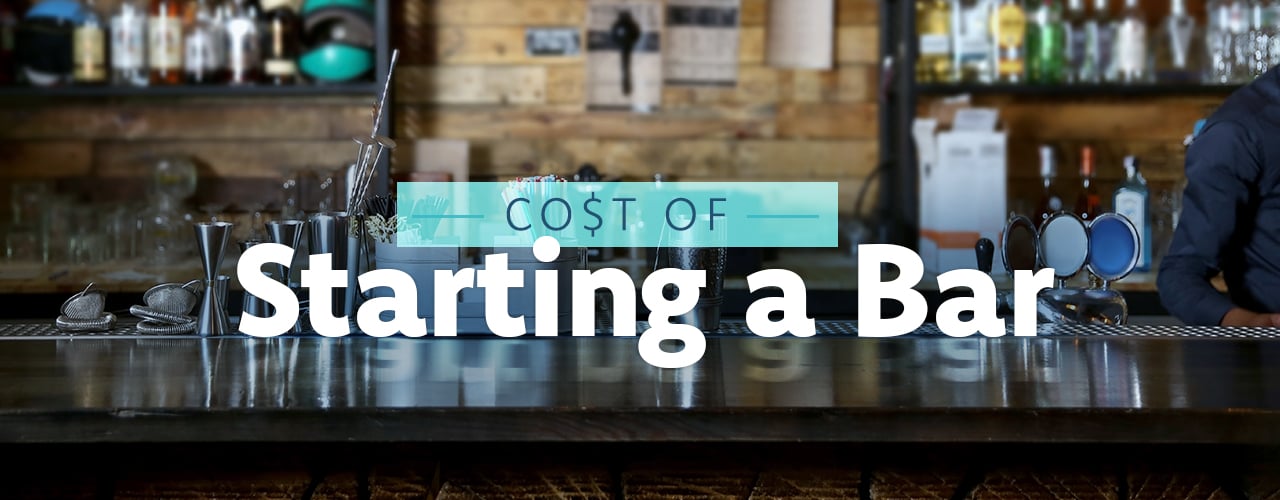
On average, opening a bar costs between $174,000 and $850,000. Your location and the type of bar you plan to open will determine the exact number. Whether you want to start a beer garden or a trendy cocktail lounge, we help you break down the individual costs so you can start budgeting for your dream bar.
Shop All Bar SuppliesBar Location Costs

Whether you lease or buy your space will greatly affect your startup costs. In addition to the costs listed below, you must deposit 1 to 3 months’ rent to lease a bar. If purchasing a bar, you must prepare to pay 20% of your location’s value upfront. The most affordable option is purchasing an existing bar.
- Renting or Leasing - $125,000 - $550,000
- Mortgage - $175,000 - $850,000
- Purchasing an Existing Bar - $25,000
Basic Bar Startup Costs
Since leasing is the most common route for new bar owners, we break down average bar startup costs if you’re leasing a commercial space for a small to average-size bar:
- Building Costs - For an average-sized bar, the cost of renting your space is generally around $110,000. This includes the initial rent payments and any remodeling required. A lease agreement requires much less capital than buying a location outright and provides more freedom to play with your concept than buying an existing bar. In the unfortunate case that your business doesn't thrive, renting provides an easier exit strategy.
- Liquor License Costs - You need a liquor license to legally sell alcohol. The average cost of a liquor license is $3,000, but this will vary from state to state and even from county to county. For the most up-to-date information on the cost of a liquor license in your area, visit the website of your state's Alcoholic Beverage Control agency.
- Permits and Insurance Costs - Just as with opening a restaurant, you'll be required to obtain the correct licenses and permits when you open a bar. The average cost for permits is $5,000 but this will vary depending on what types of permits you need. Some permits are location-specific, and others are considered a standard requirement. Business licenses, a certificate of occupancy, and a building health permit are examples of typical permits you'll need to open your bar.
- Inventory Costs - On average, your initial bar inventory purchase will cost $6,000. In addition to purchasing alcohol, you'll also need other bar essentials like mixers and blending equipment.
Bar Startup Costs by Business Type
The type of bar you choose to operate will greatly affect your startup costs. We provide additional items required by popular bar businesses, so you can budget accordingly.
- Brewpub - If you choose to brew your beer, make sure to include the cost of brewing equipment in your calculations.
- Sports Bar - An important component of a sports bar is the audio and visual equipment you'll need to broadcast sports games for your guests.
- Nightclub/Lounge - Budget for promotions, an entertainment license, DJ equipment, a dance floor, and any special lighting.
- Bar and Grill - If you plan to serve bar food, you must also account for food costs in your initial inventory expenses.
Bar Operating Costs and Overhead

In addition to startup costs, you must also consider operating costs and overhead. The average bar will incur about $20,000 in operating costs each month. A major reason bars fail is their operators use up all their capital on startup costs and don't account for the expenses that come later. It typically takes around two years for a brand-new bar to start reaping significant profits, so you must tuck money away to carry you through. Staff, rent, and inventory replenishment are going to be your three largest monthly expenses. We break down what the average bar will need to spend on each category.
- Staff - $13,000
- Rent - $6,000
- Inventory Replenishment - $1,000
- Total Average Monthly Costs - $20,000
Bar Profit Calculation
With all these expenses, you may wonder how bars make a profit. The average monthly earnings for a bar are $25,000. If you remove operating costs of $20,000 from your earnings, you're left with a monthly profit of $5,000. Take your total startup cost and divide it by your monthly earnings to see how many months it will take to get out of the red and start making a profit:
Start-Up Cost ($125,000) / Monthly Profit ($5,000) = 25 Months
How to Run a Profitable Bar
Despite all the overhead costs and ongoing expenses, a bar is one of the most profitable businesses in the food and beverage industry. On average, bar profit margins are between 78% and 80%, while the average restaurant profit margin is between 3% and 5%. Here are some tips for making your bar profitable:
- Offer Mocktails - The trend toward drinking mindfully or eliminating alcohol has increased the demand for mocktails and zero-proof liquors. Mixing mocktails into your bar menu not only meets this demand, but it also greatly increases your profits because you get to make delicious drinks without the cost of using liquor.
- Promote Top-Shelf Liquor - To make top-shelf bottles accessible to all, use them as a special part of your cocktail offerings, allowing people to enjoy more expensive alcohol without having to purchase an entire bottle. This boosts your sales and allows you to use less of the top-shelf liquor for each beverage.
- Host Bar Activities - From hosting trivia nights to having games like corn hole present, activities, and live bar events help create a sense of community. If you pair excellent drinks with a fun social atmosphere, you’ll earn regular clientele.
- Invest in Marketing - You can have the best drinks and atmosphere but that means little if no one knows you exist. From social media to community engagement, invest in marketing strategies to promote your bar.
Back to Top
Exploring the financials of opening your bar is going to provide you with some key information to include when you write your business plan. Not only will it help you prepare for every possible expense, but it will also help you to reach out to possible investors. When factoring your bar startup costs, remember that you will have bad months and good months, which is why it's so important to account for your future operating costs.





